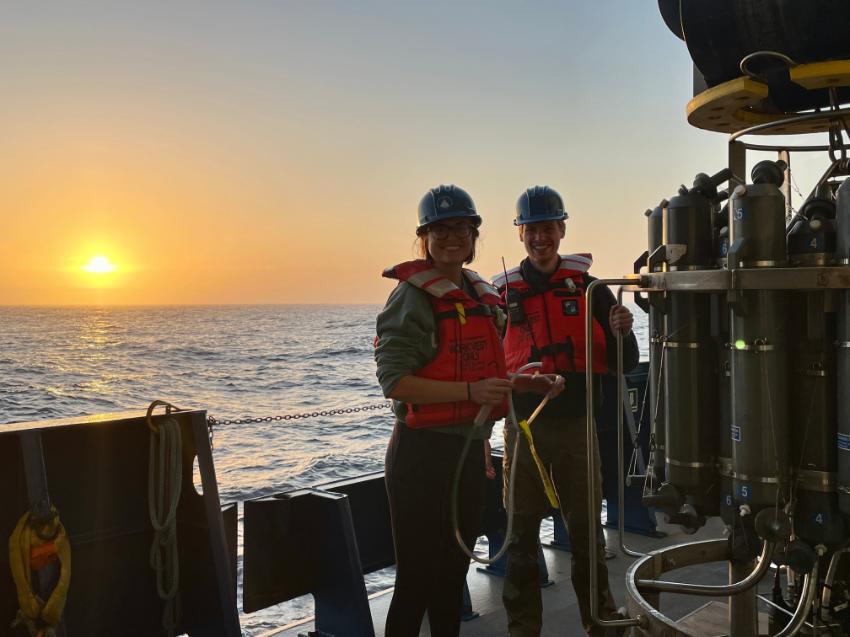Uncovering how the Gulf Stream impacts the fisheries & the ecosystem on the Southern New England Shelf
Dr. Avijit Gangopadhyay and his research team were involved in a multi-institutional research cruise for their collaborative research project funded by the National Science Foundation that seeks to unfold the impact of the changing nature of the Gulf Stream and its rings on the ecosystem in the continental shelf and slope region of the northeast U.S.

Dr. Avijit Gangopadhyay, Professor of Estuarine and Ocean Sciences at UMass Dartmouth’s School for Marine Science & Technology (SMAST), recently returned from a cruise onboard the UNOLS research vessel R/V Neil Armstrong. During a 2-week period, they gathered multi-disciplinary data using multiple sensors for their collaborative research project “Recent Changes in Shelfbreak Exchange Process Oriented Observations of Salinity Maximum Intrusions.” The project is funded by the National Science Foundation (NSF).
Recent warming in the continental shelf and slope region of the northeast U.S. has raised a number of concerns about impacts on the ecosystem and commercial fisheries. Observations from a number of sources have shown warm-core ring water masses have been transported across the continental shelf much further onshore in recent years. Warm core rings, which are mesoscale eddies that break off from the Gulf Stream, may contribute to extreme warming conditions in the water masses from the Mid-Atlantic Bight to the Gulf of Maine/Georges Bank, along and across the Shelf break Front, in the slope waters and beyond.
Using a combination of analysis of existing historical data from various sources, Gangopadhyay and his research team Adrienne Silver (PhD student at SMAST), and oceanographers from Woods Hole Oceanographic Institution, the University of Minnesota-Duluth, and Dalhousie University in Nova Scotia, Canada, set out on a two-week cruise aboard the R/V Neil Armstrong to document their observations. The cruise was led by Dr. Glen Gawarkiewicz from WHOI, who was the chief Scientist and the PI on the NSF project.
“We are studying one particular process in which shelf and ring water may be transported tens of kilometers shoreward of the edge of the continental shelf. This process, called the Salinity Maximum Intrusion, happens when an appreciable volume of warm and salty water from the Slope Sea crosses the shelf break and enter the shelf water. This can happen at different levels, near-surface, mid-depths, and along the sloping bottom. The intrusion is measured by the maximum difference in salinity between the intruding water and the ambient shelf water over the thickness of the intruding layer.” Gangopadhyay explains. “The dynamics of salinity intrusions on the Northeast U.S. Shelf remain unresolved. Given recent changes in the structure of temperature and salinity on the continental shelf in the Middle Atlantic Bight, it is likely some characteristics of the salinity maximum intrusions have also changed. Likewise, given the increasing number of Warm Core Rings observed south of New England, it is likely that offshore forcing for these intrusions has increased, possibly increasing the frequency of occurrence.”
Dr. Glen Gawarkiewicz, the Chief Scientist and the WHOI principle investigator in the NSF project have been studying such intrusions since the early nineties. Gawarkiewicz says, “Salinity maximum intrusions were generally defined by a change of 0.2 practical salinity units (PSU). In this cruise, we have seen many intrusions of 2-3 PSU, which are an order of magnitude higher. The intruding water is also of Gulf Stream or Warm Core Ring character. This is consistent with the increasing number of rings impinging on the shelf break and their subsequent impact on the shelf ecosystem in recent years. These need to be studied with a follow-up program after the Pioneer Array is relocated. This is critical to understand and monitor such intrusions.”
These intrusions might have different implications for Squids and different species of fish such as Cod, Haddock, and Atlantic Herring. One of the partners in this project is the Commercial Fisheries Research Foundation (CFRF). Dr. David Bethoney, Director of CFRF and an alum of SMAST is leading efforts to build such connections. Graduate Student, Adrienne Silver is actively participating in these collaborative efforts with WHOI, CFRF, and NOAA for her PhD studies at SMAST.
From June 21 through July 2, the team mapped out the intrusions using three autonomous underwater vehicles (including one long-range AUV with missions for 11 and 3 days) along with shipboard CTD, turbulence profiling with a vertical microstructure profiler, and a SUNA (Submersible Ultraviolet Nitrate Analyzer). A second cruise is scheduled for September 2021. You can follow their journey and findings on their blog.